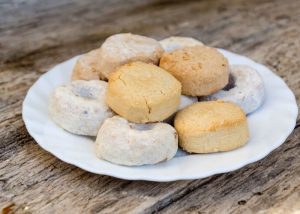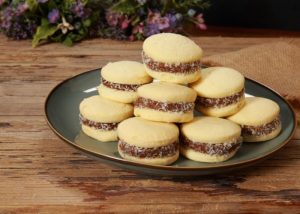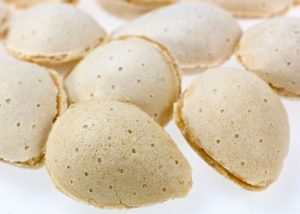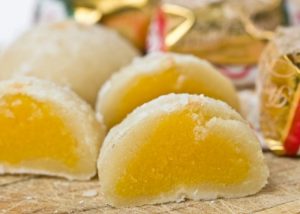The Spanish love their cakes, sweets, and treats, but at this time of year there is even more to enjoy. InSpain.News look at some of the more traditional festive treats for you to look out for.
Chocolate, almonds, and marzipan are in abundance at this time of year in Spain. However, we will begin with one such Spanish sweet treat containing almonds that are included in every Christmas gift I give.
Turrón
Turrón can be found in every supermarket and bakery. But there are so many varieties of turrón, that there are even some shops that sell only this.
Traditionally, the main ingredients of this nougat-style treat are peeled roasted almonds and honey. They can be hard (duro), or soft (blando). Then there are all the other flavours and combinations.
Roscón de Reyes
As mentioned in our previous article, this ring-shaped cake, is also known as Three Kings’ Cake, and owes its name to the Three Kings’ Day (January 6th), the day it is usually eaten after the main family meal. The sweetbread of the cake is usually filled with cream and topped with colourful candied fruits. Inside the cake, there is a broad bean and a figurine. The person who has the bean must pay for the cake the following year. Whereas the person with the figurine is crowned the Roscon´s king.
Mantecados
The name mantecado comes from “manteca” which is pig fat or lard. This is one of the key ingredients of these shortbread cookies which dates back to the 16th century. At this time, there was a surplus of grain and lard, so they added sugar and egg white with some other ingredients to make different varieties, such as cinnamon, chocolate, lemon, etc. However, as with turrón, there are now so many types of flavours to choose from.
 Polvorones
Polvorones
These popular sweets are similar to Mantecados except they contain much more flour and no egg white. They all have almond inside and the sugar would be powdered instead of granulated. The polvorones are covered in flour which gives their name “polvo” meaning dust. These are only eaten during the festive period and can be found wrapped in colourful paper. They usually just crumble and fall apart when you open them. They are often enjoyed along with a liquor or sweet wine.
Hojaldrinas
Hojaldrinas have a similar flaky, crunchy texture to the mantecados and polvorones. However, their name comes from the layers of puff pastry (hojaldre) that are put inside the sweet. White wine and orange juice are a MUST added to the dough to make the hojaldrinas one of the most mouth-watering Christmas sweets. The pastry is made using lard or a mix of lard and butter.
Alfajores
Almonds are a popular theme for Christmas treats in Spain. They are also present in Alfajores biscuits, as well as other nuts and honey. These biscuits can also be filled with honey dough, toffee, and are often rolled in coconut or hundreds and thousands. They can also contain spices such as clove, sesame, cinnamon, and anise.
The origins of the Alfajor date back to Ál-Andalus when Arabs used to rule a significant part of Spain. They remind me of empire biscuits.
Roscos de vino
The sweet wine of Malaga, Moscatel, and sometimes brandy is used for these treats. Shaped into a ring (rosco) like a donut, these are made with flour, lard, almonds, and spices similar to those used in Alfajores. They are then topped with icing sugar.
Pestiños
These sweets are associated with religious celebrations. In addition to Christmas, these are also popular during the Holy Week. Using flour made into dough and deep-fried in olive oil, they are covered in sugar or honey and cinnamon.
Borrachuelo
With the same dough as the pestiño, this sweet is filled with Cabello de Ángel (angel hair), that which is covered in sugar and honey. Other ingredients include sweet white wine and anisette. This is how the sweet came to be named (borracho means “drunk” in Spanish).
Pan de Cadiz
Pan de Cadiz is stuffed marzipan filled with candied fruit, and Cabello de Angel (angel hair). It can also be filled with egg yolk cream (cream de yema) and sweet potato.
It was invented in the 50s by Antonio Valls Garrido, a pastry chef from Cadiz.
 Almendras rellenas
Almendras rellenas
Although Almendras rellenas means “stuffed almonds”, they are actually thin wafer shells, filled with hazelnut, almond, and chocolate cream. They are very more-ish.
Bolitas de coco
These little coconut balls are like little bounties, made with desiccated coconut, condensed milk, chocolate, and margarine. They also come in different varieties with additional ingredients such as orange or carrot.
Tronco de Navidad
Originating from the French bûche de Noël, this is Spain’s version of the Yuletide log . This cake is made to look like a log ready for the fire to keep out the cold of winter.
Figuritas de marzipan
Marzipan has a long tradition in Spain, and at this time of the year, bakers make beautiful marzipan figures and scenes to decorate their shop windows. And as marzipan is mostly made of grounded almonds, egg, and icing sugar, it is ideal for people looking for gluten-free treats. Other flavours can be added, such as orange.
Piñonates
This is a type of long stick fried dough that is made into a bar and covered in a honey-based syrup with lots of spices and nuts. It is quite a process to make, but it is a very old, traditional recipe that never goes out of style.
Yemas and Glorias
Yemas are egg yolks and marzipan preserved in sugar. They are one of the creamiest and sweetest Spanish treats you will find!
Glorias are sweet potatoes instead of eggs stuffed in the marzipan.
Both are covered in icing sugar and cinnamon.
Neules (barquillos)
These are thin waffles rolled like a thick straw. They come either plain, covered in chocolate, stuffed with almond butter, or other flavours and fillings. The plain ones can be dipped in a glass of fizzy wine!
Also read: Warm Sangria – perfect for winter evenings in Spain

 Polvorones
Polvorones

 Almendras rellenas
Almendras rellenas
